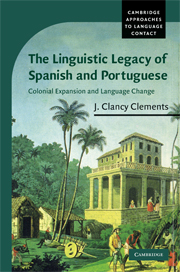Book contents
- Frontmatter
- Contents
- List of figures
- List of maps
- List of tables
- Series editor's foreword
- Acknowledgements
- List of abbreviations and acronyms
- 1 Language contact, language learning, and language change
- 2 The general socio-historical context of Portuguese and Castilian
- 3 Portuguese- and Spanish-lexified creole languages
- 4 Bozal Spanish of Cuba
- 5 Chinese Coolie Spanish in nineteenth-century Cuba
- 6 Chinese Immigrant Spanish
- 7 Andean Spanish
- 8 Barranquenho
- 9 Contact, cognition, and speech community
- Appendix A
- Appendix B
- Bibliography
- Author index
- General index
7 - Andean Spanish
Published online by Cambridge University Press: 30 September 2009
- Frontmatter
- Contents
- List of figures
- List of maps
- List of tables
- Series editor's foreword
- Acknowledgements
- List of abbreviations and acronyms
- 1 Language contact, language learning, and language change
- 2 The general socio-historical context of Portuguese and Castilian
- 3 Portuguese- and Spanish-lexified creole languages
- 4 Bozal Spanish of Cuba
- 5 Chinese Coolie Spanish in nineteenth-century Cuba
- 6 Chinese Immigrant Spanish
- 7 Andean Spanish
- 8 Barranquenho
- 9 Contact, cognition, and speech community
- Appendix A
- Appendix B
- Bibliography
- Author index
- General index
Summary
Introduction
The Americas – North, Central, and South America – were initially populated, as far as we know, around or before 11,000 BCE by way of the Bering Strait and Alaska. Although between then and now some contact may have taken place between South America and Polynesia, and the Norse did reach North America prior to 1492, such contacts had no major impact on the societies that developed in the Americas. The ‘collision’ between the Old World and the New, as Diamond (1999:67) expresses it, began in 1492 with Columbus' ‘discovery’ of the densely populated Caribbean Islands. Diamond speaks of proximate and immediate causes for the relatively rapid colonization of the New World by Europeans. In essence, it can be said that disease, superior weaponry, and the literate culture of the Europeans played decisive roles in the rapid colonization of South America by the Spanish. Regarding disease, Diamond (ibid.:67–81) notes that the Spaniards had been exposed to many diseases from their centuries-long close proximity to domesticated animals. They had thus developed immunity to diseases which had become endemic among them; the indigenous populations, on the other hand, had had no exposure to these diseases and so were decimated in the first New World–European encounter. As for weaponry, the Incas' clubs, maces, and hand axes (made of stone, bronze, and wood), as well as their slingshots and quilted armour, were no match for the Spanish horses, guns, steel swords, and steel armour. Finally, although Francisco Pizarro, the conqueror of the Inca Empire and founder of Lima, Peru, was illiterate, he had a wealth of information at his disposal from written history, including written accounts of how Cortés defeated Montezuma in what is now Mexico.
- Type
- Chapter
- Information
- The Linguistic Legacy of Spanish and PortugueseColonial Expansion and Language Change, pp. 158 - 189Publisher: Cambridge University PressPrint publication year: 2009



